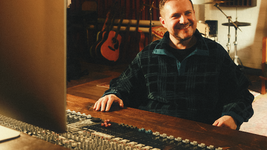‘Our Time on Earth’ is Invaluable: Let’s Not Lose It
- Lara Mae Simpson
- May 9, 2022
- 4 min read
In the new exhibition at the Barbican, I am standing before a magnificent tree. It is tall and covered with moss and plants, its roots stretching out beyond where I can see. I am circling around it and hearing the sounds of the deep forest it is hidden in. I watch countless nutrients circulate through its limbs, watch its layers slowly unfold until it takes on a magical quality. I breathe. I remember that I belong on the same beautiful planet that this tree inhabits.

This is how the Barbican’s ‘Our Time on Earth’ begins–a connection with nature. At the exhibition’s opening, guest curator Caroline Till explained why it is split into the three chapters ‘Belong’, ‘Imagine’, and ‘Engage’: before we tackle the climate emergency, we must start by reminding ourselves that we ‘belong’ on Earth amongst all the other species. With alarming headlines about global warming and rising sea levels, anger at governments who refuse to enact significant change and our helplessness at our own destruction, it is vital that we take a moment to reflect on what it is that we are fighting for. Once we recall how all living species depend on each other, only then can we ‘imagine’ possible solutions to the crisis and efficiently ‘engage’ with taking action to sustain this ecology.
Thus, we move on from the tree in Sanctuary of the Unseen Forest, produced by Marshmallow Laser Feast, to ‘Imagine’. This largest section begins with Refuge for Resistance by Superflux. The scene depicts a fictional dining experience with multiple species, the table laden with unique crockery for different animals. The attention to detail is stunning, as is the sense of immersion you get from the speakers all around you–when it begins to rain on the ‘window’ screen that shows a futuristic world, you can hear it fall. In this way, we are encouraged to envisage a future where all species are equal and humans do not exploit natural resources.
This leads us into the next rooms which I thought were amongst the most interesting.
We enter a ‘fabric forest’, as the exhibition calls it, created by Indigenous leaders from Brazil and Choose Earth. The hanging cloths present their pleas for better treatment of the planet: ‘We are the ones who through our hearts hear the cry of the Earth’. We read that Indigenous people make up 5% of the world’s population but they protect 80% of our biodiversity. Thus, it is those who are least accountable for the climate crisis that are affected the most by it. The short film Wild Arrow #7 by Indigenous collective Selvagem reminds us just how many natural resources the Global North demands such as coffee, tea, and sugar, and the devastating impact this has on the land that Indigenous people are connected to.

Therefore, the Symbiocene looks at ways we can combat climate change by collaborating with Indigenous communities. This is opposed to ignoring their ideas and pushing ‘Western-led solutions’ that utilise ‘future-oriented, colonial technologies’, as the exhibition states. One possibility that this project explores is combining the ‘living root bridge technology’ of the Khasi people with urban transport networks, installing natural walkways in cities that would diminish air pollution and improve physical and mental health. Images, 3D models, and recorded Teams calls from experts make for a highly interesting approach to the climate emergency.
Another intriguing possible solution we are asked to ‘imagine’ is Planet City: what if ten billion humans retreated to a compacted city that takes up only a fraction of the Earth’s surface, allowing the rest of the planet to rejuvenate? The calculated statistics are staggering: this city would contain ‘4,311,543,982 bicycles, ‘49,445,671,570 solar panels’, ‘932 zettabytes of data’ and over two billion tomatoes. In his artist statement, creator Liam Young describes it as ‘not a neo-colonial masterplan imposed from a single seat of power’ but rather, ‘a collaborative work of multiple voices and cultures’ that tackles the ‘ideological’ problems of climate change instead of solely focusing on the ‘technological’. This project showed to me just how imaginative our approaches to the climate crisis can be.
The exhibition also highlights the extensive environmental damage of the fashion industry, with Biofabricate alternatively displaying clothes made from microbes, leather made from mycelium, and spun yarn from seaweed. I was somewhat dubious that ZARA collaborated as designers on this project when it is a leading fast fashion brand, but I hope that this is a step forward in the right direction. The biological clothes were undeniably fascinating and something I could see becoming more widespread. We also learn about sustainable building materials in comparison to concrete, which is the most used resource after water and accounts for 8% of carbon emissions. We learn about Queer Ecology–a potential world where identity is fluid and thus the hierarchical binary between humans and nature could vanish–through amusing motion capture that creates a plant-like version of yourself on-screen. We learn about environmentally friendly economic systems through a mini video game. This exhibition, although urgent, is fun.

Finally we get to ‘Engage’, starting with Stories of Change by Wallmakers and The Earth Issue: videos of ten various activists and grassroots organisations explaining how they are tackling the climate crisis. Although inspiring, this section felt slightly overwhelming for me with all the videos playing at once, making me wonder whether I could truly make a difference. However, the closing Sonic Waterfall by Silent Studios, designed to alleviate anxieties and bring about a sense of unity, was certainly effective. Hearing the rushing sounds of a waterfall, we are once again reminded of the beauty of nature, allowing us to breathe like we did with the tree in ‘Belong’. The light shines on the waterfall and then onto us, almost as if to ask the exhibition’s overarching question–it is our time on Earth, so how are we going to save it?
‘Our Time on Earth’ is essential. With its mixture of inventive science and moving art from a global perspective, I left feeling more hopeful for our planet’s survival. The exhibition is not just a pressing call to action but also a beautiful reminder of our connection with nature. Our existence in this world, amongst all its other wonders, is precious. We cannot let our time here run out.
‘Our Time on Earth’ is on at the Barbican Centre until the 29th of August 2022 and tickets can be bought here.
Edited by Maisie Allen, Literature Editor


































Comentarios